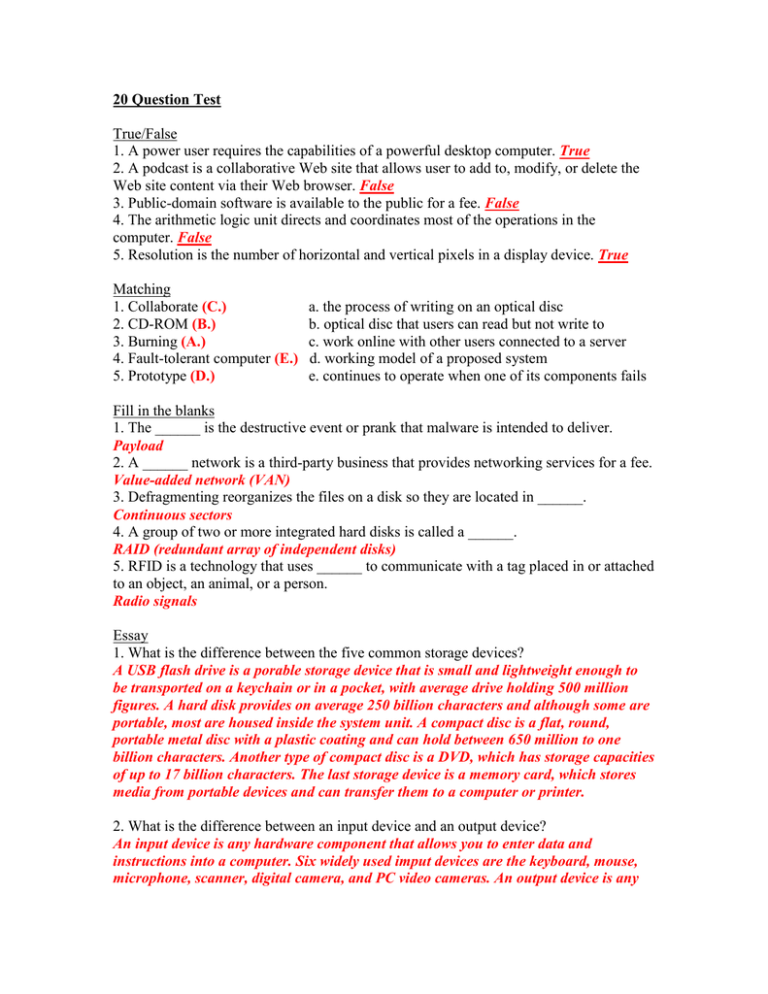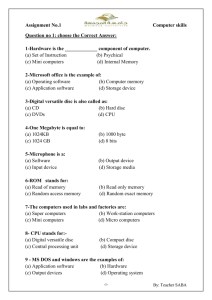20 Question Test True/False
advertisement

20 Question Test True/False 1. A power user requires the capabilities of a powerful desktop computer. True 2. A podcast is a collaborative Web site that allows user to add to, modify, or delete the Web site content via their Web browser. False 3. Public-domain software is available to the public for a fee. False 4. The arithmetic logic unit directs and coordinates most of the operations in the computer. False 5. Resolution is the number of horizontal and vertical pixels in a display device. True Matching 1. Collaborate (C.) 2. CD-ROM (B.) 3. Burning (A.) 4. Fault-tolerant computer (E.) 5. Prototype (D.) a. the process of writing on an optical disc b. optical disc that users can read but not write to c. work online with other users connected to a server d. working model of a proposed system e. continues to operate when one of its components fails Fill in the blanks 1. The ______ is the destructive event or prank that malware is intended to deliver. Payload 2. A ______ network is a third-party business that provides networking services for a fee. Value-added network (VAN) 3. Defragmenting reorganizes the files on a disk so they are located in ______. Continuous sectors 4. A group of two or more integrated hard disks is called a ______. RAID (redundant array of independent disks) 5. RFID is a technology that uses ______ to communicate with a tag placed in or attached to an object, an animal, or a person. Radio signals Essay 1. What is the difference between the five common storage devices? A USB flash drive is a porable storage device that is small and lightweight enough to be transported on a keychain or in a pocket, with average drive holding 500 million figures. A hard disk provides on average 250 billion characters and although some are portable, most are housed inside the system unit. A compact disc is a flat, round, portable metal disc with a plastic coating and can hold between 650 million to one billion characters. Another type of compact disc is a DVD, which has storage capacities of up to 17 billion characters. The last storage device is a memory card, which stores media from portable devices and can transfer them to a computer or printer. 2. What is the difference between an input device and an output device? An input device is any hardware component that allows you to enter data and instructions into a computer. Six widely used imput devices are the keyboard, mouse, microphone, scanner, digital camera, and PC video cameras. An output device is any hardware component that conveys information to one or more people. Four commonly used output devices are a printer, monitor, speakers, and a portable media player. 3. How are blogs, wikis, and podcasts different? A blog is an informal Web site consisting of time-stamped articles, or posts, in a diary or hournal format, usually listed in reverse chronological order. A wiki is a collaborative Web site that allows users to create, add to, modify, or delete the Web site content via their Web browser. A podcast is recorded audio, usually an MP3 file, stored on a Web site that can be downloaded to a computer or a portable media player such as an iPod. 4. How is a Web page different from a Web site? A web page is an electronic document on the Web that contains text, graphics, audio, and video and can have built-in connections to other Web pages. A Web site is a collection of related Web pages and associated items, such as documents and pictures, stored on a Web server. 5.What are the benefits of document management software? Document management software provides a means for sharing, distributing, and searching through documents by converting them into a format that can be viewed by any user. The converted document, which mirrors the original document’s appearance, can be viewed and printed without the software that created the original document.


